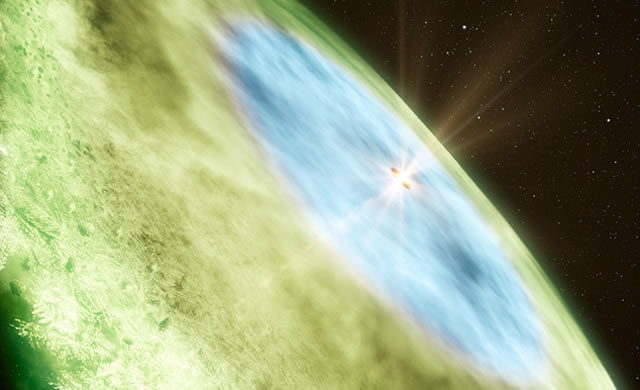
Un gelido punto di riferimento per la formazione di pianeti e comete – La “linea delle nevi” è stata immortalata per la prima volta in un sistema planetario neonato. La cosiddetta “linea della neve”, quella che segna il limite delle nevi perenni, che si trova nel disco intorno alla stella simile al Sole TW Hydrae, ci promette nuove informazioni sulla formazione di pianeti e comete, sui fattori che decidono la loro composizione e sulla storia del Sistema Solare. I risultati vengono pubblicati oggi sulla rivista Science Express.
Alcuni astronomi, utilizzando ALMA (Atacama Large Millimeter/submillimeter Array) hanno scattato la prima fotografia in assoluto del limite delle nevi in un sistema planetrio neonato. Sulla Terra, il limite delle nevi si forma ad alta quota, dove le basse temperature convertono l’umidità dell’aria in neve. La linea è chiaramente visibile sulle montagne, dove termina la cima coperta di neve e inizia la parete rocciosa. Il limite della neve si forma in modo simile intorno a una giovane stella, nelle lande remote del disco da cui si formano i sistemi planetari. Partendo dalla stella e spostandosi verso l’esterno, l’acqua (H2O) è la prima a congelare, formando la prima linea della neve. Più in là, la temperatura cala ancora e si congelano e diventano neve molecole più esotiche, come l’anidride carbonica (CO2), il metano (CH4) e il monossido di carbonio (CO). Queste diverse “nevi” coprono i grani di polvere con un rivestimento appiccicoso che svolge un ruolo fondamentale nell’aiutare i grani a superare la loro naturale tendenza a rompersi nelle collisioni: diventano così i mattoni fondamentali di pianeti e comete. La neve aumenta anche la quantità di materia solida disponibile e potrebbe velocizzare drasticamente il processo di formazione dei pianeti. Ciascuno di questi limiti di neve – per acqua, anidride carbonica, metano e monossido di carbonio – potrebbe essere legato alla formazione di un particolare tipo di pianeta. Intorno a stelle simili al Sole, in un sistema planetario come il nostro, la linea della neve di acqua corrisponderebbe alla distanza tra le orbite di Marte e di Giove, mentre il limite della neve di monossido di carbonio corrisponderebbe all’orbita di Nettuno.
Fonte/Leggi tutto → ESO.org
A frosty landmark for planet and comet formation – A snow line has been imaged in a far-off infant planetary system for the very first time. The snow line, located in the disc around the Sun-like star TW Hydrae, promises to tell us more about the formation of planets and comets, the factors that decide their composition, and the history of the Solar System. The results are published today in Science Express.
Astronomers using the Atacama Large Millimeter/submillimeter Array (ALMA) have taken the first ever image of the snow line in an infant planetary system. On Earth, snow lines form at high altitudes where falling temperatures turn the moisture in the air into snow. This line is clearly visible on a mountain, where the snow-capped summit ends and the rocky face begins. The snow lines around young stars form in a similar way, in the distant, colder reaches of the dusty discs from which planetary systems form. Starting from the star and moving outwards, water (H2O) is the first to freeze, forming the first snow line. Further out from the star, as temperatures drop, more exotic molecules can freeze and turn to snow, such as carbon dioxide (CO2), methane (CH4), and carbon monoxide (CO). These different snows give the dust grains a sticky outer coating and play an essential role in helping the grains to overcome their usual tendency to break up in collisions, allowing them to become the crucial building blocks of planets and comets. The snow also increases how much solid matter is available and may dramatically speed up the planetary formation process. Each of these different snow lines — for water, carbon dioxide, methane and carbon monoxide — may be linked to the formation of particular kinds of planets. Around a Sun-like star in a planetary system like our own, the water snow line would correspond to a distance between the orbits of Mars and Jupiter, and the carbon monoxide snow line would correspond to the orbit of Neptune.
Source/Continue reading → ESO.org





















